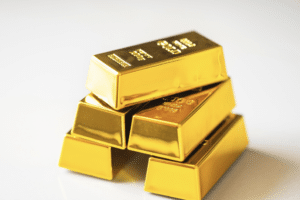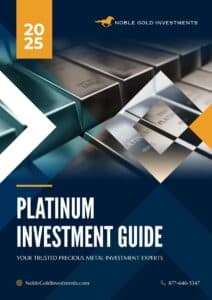It may not be immediately apparent, but there is a correlation between unemployment rates and gold prices that precious metals investors watch carefully. When unemployment rates rise, the Federal Reserve often expands the money supply and lowers interest rates, leading to upward pressure on gold prices.
This correlation is driven by the broader economic context where a weaker job market prompts stimulus measures, making gold a more attractive safe-haven asset.
Conversely, decreases in unemployment rates generally suggest a stronger economy, with the Federal Reserve likely to tighten monetary policy. This scenario typically results in lower gold prices due to higher interest rates and reduced liquidity. Such dynamics make the unemployment rate a vital indicator for forecasting gold price movements.
Recent trends, such as significant upticks in U.S. unemployment claims, have underscored these patterns. Data showing rising unemployment often fuels expectations of rate cuts by the Federal Reserve, directly impacting gold prices and reinforcing the metal’s role as a hedge against economic uncertainty.
Gold as an Investment Asset
Gold, alongside other precious metals, serves as a crucial asset class for many investors due to its historical stability and distinctive properties. Understanding the specific features of gold and examining its past performance can provide valuable insights.
Characteristics of Precious Metals
Precious metals like gold, silver, platinum, and palladium are highly valued for their rarity and intrinsic qualities. Gold, in particular, stands out due to its durability, malleability, and resistance to corrosion. These characteristics make it useful not only as a monetary standard but also in various industrial applications.
Gold is often perceived as a safe haven investment during economic instability. This is because it tends to retain its value or even appreciate when other asset classes like stocks and bonds are underperforming.
Its liquidity makes it an accessible and versatile asset that is easily traded in global markets. For these reasons, investors often allocate a portion of their portfolios to precious metals to diversify and mitigate risk.
Gold’s Historical Performance
Historical data shows that gold has shown remarkable resilience and growth, particularly in times of economic downturns. During the 2008 financial crisis, for instance, gold prices surged from around $730 per ounce at the start of 2008 to over $1,100 by the end of 2009. This pattern underscores gold’s role as a store of value.
Investors frequently turn to gold not only for capital preservation but also for potential appreciation in times of inflation or geopolitical uncertainty. Historical performance indicates that gold can provide a hedge against market volatility, protecting wealth when currencies and other investments falter.
By examining these historical trends, investors can better understand the advantages of including gold within a diversified investment strategy. This perspective helps in making informed decisions aligned with financial goals and market conditions.
Economic Indicators and Gold Prices
Unemployment rates, GDP growth, and other key economic indicators can have a strong correlation with the movement of gold prices. These data points are central to understanding how macroeconomic variables can shape the precious metals market.
The Bureau of Labor Statistics
Investors closely watch monthly employment reports from the BLS. These reports include figures such as nonfarm payrolls, unemployment rates, and average hourly earnings. Each of these figures can trigger shifts in investor sentiment and consequently impact gold prices.
Significant changes in GDP alongside BLS reports can also play a role. For instance, a drop in GDP combined with high unemployment could drive gold prices up as a hedge against economic downturns. Conversely, strong GDP growth with low unemployment may lead to a decrease in gold prices.
Correlation Between the Job Market and Gold Market
The gold market responds directly to changes in the job market. When unemployment rises, business sentiment declines and investment strategies shift towards safer assets like gold. This behavior was observed from 2008-2016 when gold prices rose significantly with steadily increasing unemployment rates.
The correlation between the US job market and gold market highlights how macroeconomic variables impact investor demand. Unemployment data can lead to speculation on Federal Reserve rate cuts, further affecting gold prices. Therefore, understanding this correlation helps in predicting gold market trends based on job market performance.
Federal Reserve Policies and Their Influence
Federal Reserve policies play a critical role in shaping gold prices through mechanisms such as interest rates and quantitative easing.
Interest Rates and Gold
The Federal Reserve uses interest rates to manage economic stability. When the Fed raises interest rates, borrowing costs increase, making loans more expensive. This usually strengthens the dollar as investors seek higher returns on interest-bearing assets.
Conversely, lower interest rates decrease the opportunity cost of holding non-interest-generating assets like gold, driving more investment into gold. Thus, fluctuating interest rates can make gold more or less attractive to investors, directly linking the monetary policy of the Fed with gold prices.
Federal Funds Rate and Quantitative Easing
The federal funds rate is a crucial tool the Federal Reserve uses to influence the economy. By adjusting this rate, the Fed affects the cost of credit. Lowering the federal funds rate makes borrowing cheaper and encourages spending and investment while raising it has the opposite effect.
Quantitative Easing (QE) involves the Fed buying large quantities of financial assets to inject liquidity into the economy. This policy increases the money supply and can lead to higher inflation, against which many investors hedge by buying gold.
Investment Behavior and Market Dynamics
Individual investors often react to unemployment rates as indicators of economic health. When unemployment rises, concerns about economic stability prompt these investors to seek safer assets, such as gold and silver. This flight to safety results in increased demand, driving up gold prices.
Investor sentiment shifts significantly during economic uncertainty. Fear of prolonged unemployment and economic downturns encourages investments in gold. Psychological factors also play a part, as gold is traditionally viewed as a hedge against inflation and economic distress.
Financial Institutions’ Approach
Financial institutions approach market dynamics and unemployment with a more structured strategy. They closely monitor unemployment rates as part of broader economic indicators to inform their investment strategies. Higher unemployment often leads financial institutions to adjust portfolios, increasing allocations in gold to mitigate risk.
The Federal Reserve’s policies, in response to unemployment, can also influence gold prices. For example, Quantitative Easing (QE) programs aimed at stimulating the economy often result in increased money supply and inflation fears, prompting financial institutions to invest in gold.
Financial institutions rely on sophisticated risk management tools to navigate the complexities of unemployment data and its impact on the market, ensuring that their investment choices align with broader economic trends and objectives.
Performance of Gold Versus Stocks and Bonds
Gold often serves as a safe-haven investment compared to stocks and bonds, particularly during economic downturns. When unemployment rates rise, stock markets typically exhibit increased volatility, prompting investors to shift towards gold.
Bonds, meanwhile, offer fixed returns, but interest rates influenced by unemployment levels can affect their attractiveness.
- During high unemployment, stock prices often drop due to lower consumer spending and corporate earnings.
- Bonds tend to be more stable but may benefit less in low-interest-rate environments where gold thrives.
Other Popular Precious Metals
Gold isn’t the only precious metal investors consider. Silver, platinum, and palladium also have significant roles in diversified portfolios. Their prices often exhibit correlations with gold, though they also have distinct industrial applications that influence their market dynamics.
- Silver: Known for its dual role in investment and industry, silver prices can move in tandem with gold but are also influenced by industrial demand.
- Platinum and Palladium: These metals are heavily used in automotive and industrial applications. While they sometimes follow gold trends, their price movements can also be driven by industrial factors.
Buying Gold & Silver In A Precious Metals IRA
If you’re looking for a way to diversify your portfolio to protect against economic uncertainty, investing in precious metals is one of the most popular options available. New gold buyers can gain valuable insights and expert guidance in our First-Time Gold Buyers Guide—your trusted resource for getting started.
Whether you’re interested in buying physical precious metals to store at home or you’d prefer to buy them in a tax-deferred precious metals IRA, Noble Gold Investments can help you diversify your assets and secure your wealth.
Call us now at (877) 646-5347 to speak to one of our gold IRA specialists, or click here to open an account today.







